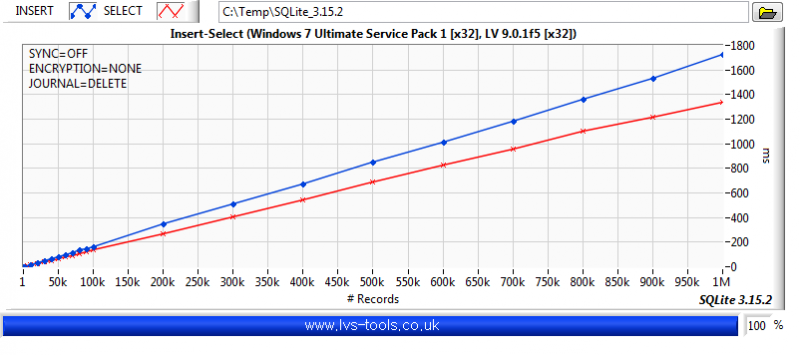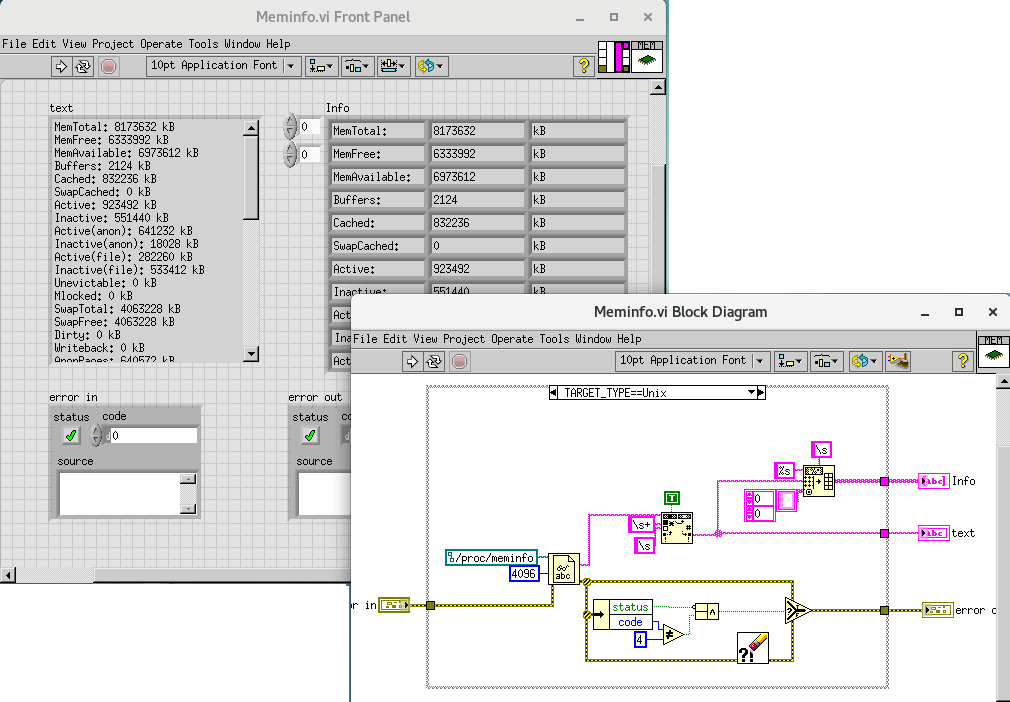-
Posts
4,996 -
Joined
-
Days Won
311
Content Type
Profiles
Forums
Downloads
Gallery
Everything posted by ShaunR
-
No need. I will explore this. From experience; a misconfigured CLFN usually results in LabVIEW disappearing without a whimper (either immediately or at some random moment) so i don't see much of a reason to have error checking and wrappers enabled at all. Especially if there is a performance benfit, no matter how minute. It doesn't seem to have a scripting counterpart. Is that correct, or have I just missed it? Is the setting sticky, or does distributed source code require the INI setting too?
-
Interesting. How does this feature compare with disabling the error checking on the Error Checking tab?
-

NXG, I am trying to love you but you are making it so difficult
ShaunR replied to Neil Pate's topic in LabVIEW General
Oh. Sorry. Missed that bit. That's a different kettle of kippers then. -

NXG, I am trying to love you but you are making it so difficult
ShaunR replied to Neil Pate's topic in LabVIEW General
it clearly states that LV 2015 isn't supported and says to forward save it to 2017. It's not really a useful test for it's conversion capabilities. -

NXG, I am trying to love you but you are making it so difficult
ShaunR replied to Neil Pate's topic in LabVIEW General
Your argument is inconsistent. If it's not a priority then making a change to remove it is allocating resource to "the least important". Leaving it in would be the least impactful. However. If you are going to change it then you might as well make it a "Preference" since that is clearly what it is. You don't seem to have a preference or, at least, are indifferent. So why advocate taking away a feature that other people obviously feel strongly about? -

NXG, I am trying to love you but you are making it so difficult
ShaunR replied to Neil Pate's topic in LabVIEW General
Just make it an ini/preference setting. The main tenor of that thread seems to be "I'm not very precise so please remove it" which, from that low point, then devolves into "my work-flow is better than your work-flow". -

Best circuit board for LabView
ShaunR replied to Ricardo de Abreu's topic in LabVIEW Community Edition
I've never used the toolkit; I'm just aware of it. I don't know of the limitations or capabilities outside of that page. I would suggest sending them an email explaining what you plan to do and they should be able to tell you.- 17 replies
-
- arduino
- raspberry pi
-
(and 3 more)
Tagged with:
-
150 samples @ 50ms is about 24K/s if the samples are double precision. The default TCPIP buffer in Windows is 8K IIRC and if NAGLE is on, you maybe filling the buffer too quickly. I would try U8, if you are currently using doubles, to reduce the data amount and see if the problem perists. If it resolves it, then I would try turning off NAGLE and increasing the buffer to 65K to use doubles again.
-

Best circuit board for LabView
ShaunR replied to Ricardo de Abreu's topic in LabVIEW Community Edition
How about the Arduino™ Compatible Compiler for LabVIEW- 17 replies
-
- 1
-

-
- arduino
- raspberry pi
-
(and 3 more)
Tagged with:
-

Best circuit board for LabView
ShaunR replied to Ricardo de Abreu's topic in LabVIEW Community Edition
There is a LabVIEW RIO Evaluation Kit which is a fraction of the cost (has FPGA on board). Alternatively you could use the Arduino with Websockets or HTTP and use LabVIEW to communicate with it. There is also an Arduino toolkit, IIRC.- 17 replies
-
- arduino
- raspberry pi
-
(and 3 more)
Tagged with:
-
You have to be logged in to see the SQLite software. The main performance criteria for SQLite is the number of rows and/or columns returned/inserted, although there have been significant improvements in recent versions (~15% over 5 years). If you look at the performance graphs, you will see that 0.6 seconds equates to about 450k rows (with 2 columns). The performance test in the Sqlite API for LabVIEW library is based on 10k rows so that you can get repeatable figures and that typically yields 10s of milliseconds. Less than that, and LabVIEW timings become dominant for the purpose of that test. If you are dumping entire tables and performance is a requirement, then a relational database is the wrong tool.
-
I imagine it is C , C++ or Javascript. NULL is a specific type of invalid pointer in C/C++ languages and "not an object" in Javascript (as opposed to "undefined"). In LabVIEW we don't really have either concepts. In JSON, it is a valid type so it depends on how you want to translate it back into a LabVIEW type. Historically I have converted in the following manner: string->empty, numeric->0, boolean->false etc. Unless, of course, it is in quotes. In that case it is the string "NULL", in whatever case, as it's implicity typed.
-
Get someone else to do it. It requires knowledge of the memory organisation of LabVIEW and C (and how different structures are allocated and stored) and most of the time a small error will completely crash LabVIEW. I would suggest asking on a C forum.
-
This demonstrates the difference. reentrancy.zip
-
Well. This will get you some of the way there (quick and dirty example). SetWindowCompositionAttribute.vi You'll still need to blend the accent colours if you want it to behave and I've no idea what will happen if you try to set the VI transparency..
-
If your looking for the Aero style blur, then that is achieved using "SetWindowCompositionAttribute". I haven't used it, I'm just aware of it, but you'll probably find examples on Github.
-
If they have internal state memory then they have to be pre-allocated. TCPIP is the most flexible, works between executables and across networks. Events and queues if they are in the same application instance..
-
If you read a text file then it will work. However. as Jordan states; it is not an actual file. It's is a text output stream from the VFS.
-
That doesn't work. I would say it is a bug but it's never worked. ¯\_(ツ)_/¯. This is what I have on my Linux box (not a cRIO though) so if you don't get anything; that is definitely a bug.
-

TCP_NODELAY.llb library
ShaunR replied to Mark Yedinak's topic in Remote Control, Monitoring and the Internet
Sure. But you're not my target audience -
OK. Got hold of my Linux Box with LabVIEW. Wire a number of bytes to the "Count" (1024?). Ignore the error 4 if you demand too many.
-

TCP_NODELAY.llb library
ShaunR replied to Mark Yedinak's topic in Remote Control, Monitoring and the Internet
That [attitude] is somewhat problematic for me in that the toolkit isn't just used for connecting safely to servers but often used in laboratories for testing device vulnerabilities and compliance. Limiting the protocols and features because "it's not good practice" or "we don't think XYZ" isn't a good fit for me and this extends outside of just TLS (for example hashes) as the toolkit is also capable of generating certificates, signing/verification and the low-level stuff like raw Diffie Hellman calculations. Of course, I'm limited by the OpenSSL implementation but limiting further based on precieved wisdom isn't what I need. -
I don't have a linux machine handy, right now, but try unchecking the "Convert EOL".
-

TCP_NODELAY.llb library
ShaunR replied to Mark Yedinak's topic in Remote Control, Monitoring and the Internet
Although it may be easier from the User end, it's still fundamentally a port of OpenSSL but without FIPS support. LibreSSL doesn't support TLS1.3, currently, and according to their Git it's sitting at OpenSSL 1.0.1 so it will be a while before it has TLS1.3. -

TCP_NODELAY.llb library
ShaunR replied to Mark Yedinak's topic in Remote Control, Monitoring and the Internet
I was failry well insulated (historically) by the NI libraries, from that, since all the LabVIEW versions share the same binaries. NI wanted the binaries to be backwards compatible so they compiled them with the compatibilty flag (and a couple of their own functions). At the time I ummed and ahhd about using my own binaries and took the easy route-especially because of cross platform support where you had no idea what versions of openSSL where installed in Linux distributions on a day-to-day baisis. Not to mention the ball-ache of actually compiling them. Your preference for an intermediary binary definately has the advantage here by being able to dynamically load function pointers wheras I'm pretty stuck with one function breaks everything. I've just spent 3 days trying to get OpenSSL 1.1.1 to compile. Perl? Really? I thought CMake was bad I always do things the hard way, though, because I don't want any dependencies. If you look at all the Windows tutorials they are mainly for Visual Studio (dependency on the MS Runtime). Try and find one for MingW Add to that that I want the same names for 32 and 64 bit and voila! Configure nightmare. I refuse to use a thunking DLL for a library that size that changes the ABI on a whim. But finally I got a VM set up to build it (after finding out far more than I wanted to about Perl). I'm not touching that VM ever again. It will remain a whole VM just to build one library on one OS. Those that do are being really stingy with them too. Considering the exponential increase in address space you would have thought if you rented/bought a VPS they would give you more than one IPv6 out-of-the-box. Not a chance!




